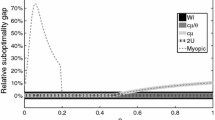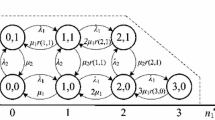Abstract
This paper extends the admission control algorithm for book-ahead and instantaneous-request calls proposed by Greenberg, Srikant and Whitt (1997) to cover multiple classes of instantaneous-request calls, each with their own traffic characteristics and their own performance requirements. As before, book-ahead calls specify their starting and finishing times, and are assumed to book far ahead relative to the holding times of the instantaneous-request calls. The book-ahead calls may be constrained by an upper-limit on the capacity that can be reserved for them. Instantaneous-request calls are admitted if the probability of interruption (or some other form of service degradation in response to the conflict) for that call is below a threshold, but now this threshold can be class-dependent, and now the interrupt probability is calculated by a normal approximation based on the central limit theorem. Simulation experiments show that the normal approximation performs as well as the previous detailed calculation in single-class examples, and that the normal approximation can be applied to multi-class examples.
Similar content being viewed by others
Explore related subjects
Discover the latest articles, news and stories from top researchers in related subjects.References
N. Bean, R.J. Gibbens and S. Zachary, The performance of single resource loss systems in multiservice networks, in: Proc. of the 14th Internat. Teletraffic Congress, 1994.
N. Bean, R.J. Gibbens and S. Zachary, Asymptotic analysis of single resource loss systems in heavy traffic, with applications to integrated networks, Advances in Applied Probability 27 (1995) 273-292.
J.A. Bucklew, Large Deviation Techniques in Decision, Simulation, and Estimation (Wiley, New York, 1990).
G.L. Choudhury, K.K. Leung and W. Whitt, An inversion algorithm to compute blocking probabilities in loss networks with state-dependent rates, IEEE/ACM Transactions on Networking 3 (1995) 585-601.
G.L. Choudhury, K.K. Leung and W. Whitt, Efficiently providing multiple grades of service with protection against overloads in shared resources, AT&T Technical Journal 74 (1995) 50-63.
E.G. Coffman, Jr., P. Jelenkovic and B. Poonen, Reservation probabilities, Advances in Performance Analysis 2 (1999) 129-158.
N.G. Duffield and W. Whitt, Control and recovery from rare congestion events in a large multi-server system, Queueing Systems 26 (1997) 69-104.
N.G. Duffield and W. Whitt, A source traffic model and its transient analysis for network control, Stochastic Models 14 (1998) 51-78.
W. Feller, An Introduction to Probability Theory and its Applications, Vol. I, 3rd ed. (Wiley, New York, 1968).
W. Feller, An Introduction to Probability Theory and its Applications, Vol. II, 2nd ed. (Wiley, New York, 1971).
A. Gersht and K.J. Lee, A bandwidth management strategy in ATM networks, Preprint, GTE Laboratories (1990).
A.G. Greenberg and R. Srikant, Computational techniques for accurate performance evaluation of multirate, multihop communication networks, IEEE/ACMTransactions on Networking 5 (1997) 266-277.
A.G. Greenberg, R. Srikant and W. Whitt, Resource sharing for book-ahead and instantaneous-request calls, IEEE/ACM Transactions on Networking 7 (1999) 10-22.
J.S. Kaufman, Blocking in a shared resource environment, IEEE Transactions on Communications 29 (1981) 1474-1481.
M.R. Leadbetter, G. Lindgren and H. Rootzén, Extremes and Related Properties of Random Sequences and Processes (Springer, New York, 1983).
J.W. Roberts, A service system with heterogeneous user requirements, in: Performance of Data Communication Systems and Their Applications, ed. G. Pujolle (North-Holland, Amsterdam, 1981) pp. 423-431.
A. Shwartz and A. Weiss, Large Deviations for Performance Analysis (Chapman and Hall, London, 1995).
D. Wischik and A. Greenberg, Admission control for booking ahead shared resources, in: Proc. of IEEE Infocom '98, San Francisco, CA, April 1998.
Author information
Authors and Affiliations
Rights and permissions
About this article
Cite this article
Srikant, R., Whitt, W. Resource Sharing for Book-Ahead and Instantaneous-Request Calls Using a CLT Approximation. Telecommunication Systems 16, 233–253 (2001). https://doi.org/10.1023/A:1016650524348
Issue Date:
DOI: https://doi.org/10.1023/A:1016650524348




